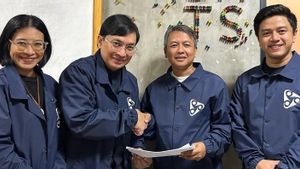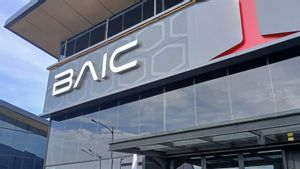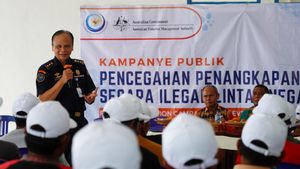JAKARTA - The original aircraft made by the nation's children, PA01 N-250 Gatotkaca, which is famous as a major milestone in the development of the country's aerospace industry will be museumed. The plane, which first took flight in 1995, shocked the world because of the technological sophistication of its day. Discussing the history of the flying Gatotkaca will not be complete without discussing the genius who initiated it: Bacharuddin Jusuf Habibie.
The news about the N-250 museum was announced by the Indonesian Air Force (AU). In a Facebook upload, the Indonesian Air Force uploaded a picture of the preparation for Sang Gatotkaca's final journey from Bandung to Yogyakarta. "The Gatotkaca is now preparing to make the long journey from Bandung to Yogyakarta Muspusdirla. Not flying, but by road, "the upload was quoted as saying Friday, August 21.
"There is a feeling of sadness witnessing the fate of the Gatotkaca now, however, this is a fact that we cannot deny ... Goodbye Gatotkaca, hopefully in a new place, you can inspire more present and future generations."
The handover of the Gatotkaca to the museum was initiated by PT. Indonesian Aerospace. This was done so that the aircraft that had flown over Indonesia's skies would inspire other young people to fly their knowledge to the fullest. Like Habibie. Gatotkaca will also be handed over to the Mandala Dirgantara Museum (Muspusdirla) in Yogyakarta.
"This submission is a follow-up to the Decree of the Indonesian Air Force Chief of Staff (SKEP) Number 284 / VIII / 2020 dated August 14, 2020 concerning the Assignment of PTDI's PA01 N-250 Aircraft Grant Receipt to be placed at Muspusdirla," said the Manager of Corporate Communications and PT Promotion DI Adi Prastowo quoted by Kompas.com, Thursday, August 20.
Almost hijacked by the PhilippinesLong before Habibie started developing the aerospace industry in the archipelago, Habibie's first offer to promote the aerospace industry came from the Philippines. At that time, the President of the Philippines, Ferdinand Marcos (1965–1986) was attracted by the genius of a man born in Pare-pare, June 25, 1936.
The Philippines also expressed its intention to invite Habibie to build the Rice Granary State aerospace industry. Quoted in the Tempo Magazine report entitled The Story of Mister Crack and Si Gatotkaca (2012), President Marcos invited Habibie who was in Germany to visit the Malacanang Palace in the Philippines in 1974.
During the meeting, Marcos offered Habibie to move to Manila. In fact, Marcos promised to undertake all the facilities Habibie wanted, including making room for Habibie to help Indonesia from Manila. However, the request was denied.

"Mr. President, I came here to prove that science is a human prerogative. It doesn't depend on the citizens, ”said Habibie before refusing Marcos's request two weeks later.
Even so, Marcos insisted on asking Habibie to work on the Philippine aerospace industry. Several months after the meeting with Habibie, Marcos met Indonesian President Suharto in Manado. Marcos gave a little bit, telling Suharto that he would build a technology and aerospace development center in the Philippines.
"I have the money and the experts," said Marcos.
"What is his name," asked Suharto.
"Bacharuddin Jusuf Habibie," replied Marcos.
"Why, that's Rudy, I have known him from childhood," Soeharto, who had known Habibie since he was 14 years old.
Habibie's returnHearing Marcos' story, Suharto didn't want to be missed. He immediately sent Pertamina's Managing Director Ibnu Sutowo to meet with Habibie in Germany. Long story short, the meeting arrived. Habibie and Ibnu Sutowo met at the Presidential Suite Hotel Hilton, Dusseldorf, Germany.
However, just entering the room, Habibie was immediately cursed at by Ibnu Sutowo. Using Dutch, Ibnu Sutowo said: Brother Rudy jij moet shaamen, als Indonesier! Brother Rudy, you should be ashamed of yourself as an Indonesian. Why did you build another country?
Habibie fell silent. Ibnu Sutowo's words were pervasive. Habibie felt embarrassed. Ibnu Sutowo then asked Habibie to immediately go to Jakarta. "This person must go home. Immediately appoint Dr. Habibie as advisor to the President Director of Pertamina," he said to his assistant, Dr Erich Sanger.
In fact, before Ibnu Sutowo, Suharto himself had asked Habibie to return home in 1970 at any time when the country needed his expertise. However, Habibie just returned to the country in March 1974.
Against foreign doubtsIn Indonesia, Habibie's dream of advancing the aerospace industry is closer to reality. Habibie was also asked to replace Nurtanio Pringgoadisurjo, who had already started manufacturing the first aircraft in Indonesia. At that time, Nurtanio led the Nurtanio Aircraft Industry (IPTN).
Since his leadership, Habibie has developed a number of technologies. He also collaborated with other countries in the manufacture of aircraft CN-235, N-2130, and the most legendary: the N-250 Gatotkaca. At that time, many doubted Habibie's capacity. Foreign media reports voiced this pessimistic tone.
Habibie sensed how biased this foreign journalist was when the N-250 was to be launched in 1995. The B-250's competitors were shocked. Foreign journalists have made predictions that when it first flew, the N-250 would fall, "A. Makmur Makka in the book Inspirasi Habibie (2020).
Not only that. Bluntly, Singapore-based and Hong Kong-based media Asiaweek wrote that Gatotkaca was not ready to fly that day. If forced, there is a possibility that disaster will occur. There is also an Australian media writing that the N-250 was not made by IPTN, but was bought from abroad which was then repainted.

Later, Habibie silenced all negative sentiment by flying a prototype N-250 aircraft into the air. The flight at that time was carried out from Husein Sastranegara Airfield, Bandung on August 10, 1995. The flight of Gatotkaca made thousands, even millions of pairs of eyes all over the country feel touched, proud, and also relieved.
Gatotkaca, which is doubtful about flying, is in fact able to fly without any problems. With this success, Gatotkaca became the first aircraft - in the subsonic speed class - to use fly by wire technology or all of its movements were computerized.
An achievement that is truly extraordinary. At that time, the N-250 was the third aircraft to apply this technology, apart from the Airbus A-340 and the Boeing 767.
Praise for the Gatotkaca N-250 flight was voiced from within and outside the country. As told by A. Makmur Makka in another book The True Life of Habibie: The Story Behind Success (2008), Gatotkaca's flight made the whole Indonesian people emotional. In fact, The Smiling General had tears in his eyes.
"Many of them were touched and shed tears, including President Soeharto and Mrs. Tien Soeharto (late) as well as Vice President Try Sutrisno and Mrs. Tuti Try Sutrisno. Several times the president was seen wiping his face with a white handkerchief. In fact, Mrs. Tien spontaneously hugged and shook hands to congratulate BJ Habibie, while holding back mixed emotions with pride, "concluded Makmur.
The English, Chinese, Japanese, Arabic, and French versions are automatically generated by the AI. So there may still be inaccuracies in translating, please always see Indonesian as our main language. (system supported by DigitalSiber.id)









